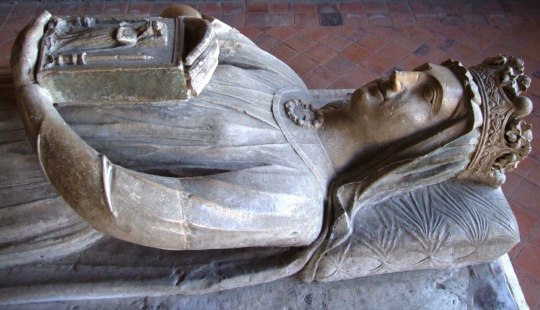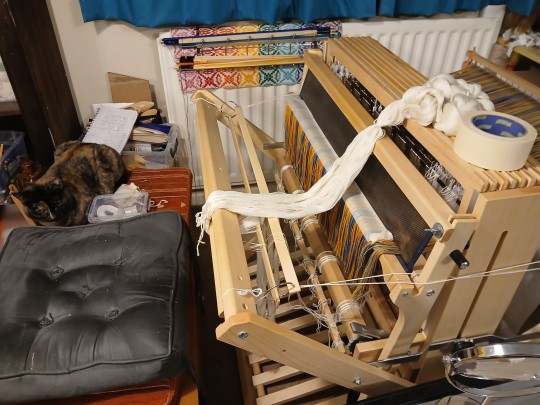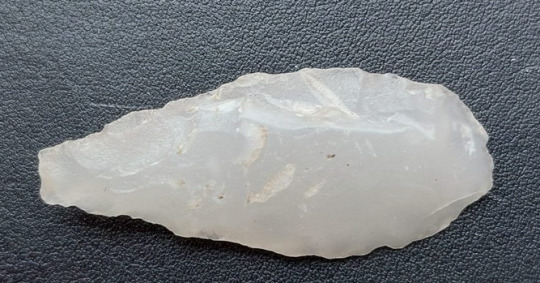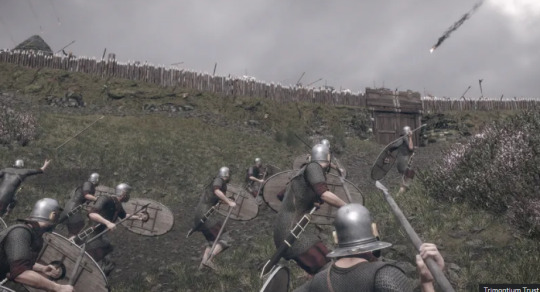Aspiring grad student needing an outlet in fandom from the stress.
Last active 3 hours ago
Don't wanna be here? Send us removal request.
Text
indeed. Very often in American museums there is the base price/regular ticket (to see the stuff that is always on display) plus an additional ticket you have to purchase (timed if the exhibition is particularly popular) to see the special exhibition. This isn't a universal thing, but I am seeing it more and more particularly in big museums with blockbuster exhibitions

66K notes
·
View notes
Text

Though Berengaria of Navarre (c.1160–1230) had few opportunities to make her mark as Queen of England, she proved a capable and determined ruler in Le Mans. Her story reveals a strong-willed survivor who carved out a place for herself despite the odds.
The princess of Navarre
Berengaria was the daughter of King Sancho VI of Navarre and Sancha of Castile. The exact date of her birth is unknown, but it likely occurred in the 1160s, based on the birthdates of her siblings.
Little is known of her early life, though she likely received a religious education. In 1185, her name appeared in a charter confirming land holdings by Navarrese ecclesiastics and nobles. At the time, she was living in the town of Monreal.
This charter may have served to display her status and capabilities as a potential diplomatic and landholding partner—or perhaps she was residing in the local monastery and engaged in religious patronage.
Marriage came soon for Berengaria. Negotiations for her union with King Richard I of England took place between 1187 and 1188.
The journey to Cyprus
Berengaria set out for Sicily in the company of her formidable future mother-in-law, Eleanor of Aquitaine, as Richard prepared to depart on crusade. The journey—and a charter witnessed along the way—marked her entry onto the international and diplomatic stage.
In 1191, they arrived in Sicily. Eleanor returned to England, while Berengaria continued her journey alongside her future sister-in-law, Queen Joanna of Sicily.
When the two women landed in Cyprus, the island’s ruler, Isaac Komnenos, attempted to take them hostage. But Berengaria and Joanna cleverly delayed, promising to disembark the next day—buying time until Richard arrived. Once reunited, Berengaria and Richard were married on May 12, 1191, in Limassol.
The withdrawn queen
Berengaria thus became Queen of England—despite not having set foot in the country. Her role during the crusade seems to have been limited. While women contributed to crusading efforts in a variety of ways—financing, diplomacy and even fighting—Berengaria appears to have focused on running her household far from the battlefield.
She and Joanna returned from the Holy Land in 1193. In Rome, they witnessed a loan agreement and successfully convinced the Bishop of Porto to act as guarantor. This event shows that, when given the opportunity, Berengaria was able to assert herself as a royal figure.
Unfortunately, her time as queen gave her few such opportunities. Richard showed little interest in the match, and it is unclear whether they ever saw each other again after the crusade. Her absence from his second coronation in England further limited her visibility and authority as queen.
She was, however, present at Richard’s funeral in 1199. But since their relationship had been distant, reports of her grief should be viewed with some skepticism.
The fighting widow
Berengaria now found herself in a precarious position—widowed, childless, without strong political allies or substantial resources. She had to fight for her rights as queen dowager and repeatedly petitioned Richard’s brother, King John, for her dower income.
In 1204, with no intercessor to support her, Berengaria took matters into her own hands. She reached an agreement with King Philip II of France, trading some of her Norman dower lands for lordship over the city of Le Mans. This deal granted her independence, income, and power.
Domina Cenommanis
Berengaria became Domina of Le Mans—a title better translated as “female lord” than merely “lady.” She was not an exception: her rule fits into a broader pattern of female lordship in the medieval world.
In Le Mans, Berengaria exercised her authority. She negotiated with kings, popes, and local powers, building a strong network of alliances. She proved to be a capable and respected ruler, holding her own against ecclesiastical authorities and participating actively in the city’s judicial and administrative affairs.
She also continued her fight for dower revenues, traveling to England in 1220. Though only partially successful—King Henry III granted her only part of what she was owed—her persistence was notable.
Berengaria was deeply invested in religious patronage. She maintained close ties with the papacy and vigorously protected the chapter of Saint-Pierre-de-la-Cour. Most importantly, she founded the Abbey of L’Épau, a project designed to secure her legacy.
Berengaria died in 1230. She was buried at the abbey she had founded.

Berengaria's effigy at L'Épau
If you enjoy this blog, consider supporting me on Ko-fi!
Further reading:
Storey Gabrielle, Berengaria of Navarre, Queen of England, Lord of Le Mans
Storey Gabrielle, “Berengaria of Navarre and Joanna of Sicily as crusading queens: Manipulation, reputation, and agency”, Forgotten queens in Early Medieval and Modern Europe
90 notes
·
View notes
Text
youtube
Some of the old memes still hit. Fifteen years on and Jane Austin's Fight Club still made me snicker.
100 notes
·
View notes
Video
One of my favorite scenes from Letterkenny
266K notes
·
View notes
Text
My LEGO build has been submitted for IDEAS.
10,000 supports are needed to be a real LEGO set.
Please support it, if you want to make it real.










16K notes
·
View notes
Text
Got reminded again of my old coworker who was a massive misogynist but also trans inclusive. Told me he believed trans women are indeed women because "only women would be stupid enough to want to be women"
I wonder what he's doing now
133K notes
·
View notes
Text
that crying “babe I’m so horny!” meme but the response references the queen’s funeral holiday
17K notes
·
View notes
Photo

STRAWBERRY HAND PIES
Follow for recipes
Is this how you roll?
2K notes
·
View notes
Text
tiktok: christinajulian_91
audio credit: anthony vincent
56K notes
·
View notes
Text
I found this youtube channel run by a pet groomer and all she posts is just. Fluffy lil sweetie pies getting groomed.
youtube
2K notes
·
View notes
Text

Imagine being tortured by one fascist regime, finding a new life in a different country, living quietly there for 38 years, and then being tortured and deported by another fascist regime to a third country because you happen to speak the language of that country.
And then imagine if your family was told you had been killed by the secret police of that second country, when really you'd just been disappeared to a black site and then shoved out the door there when they got bored with you.
Below the cut you'll find more nauseating details about something that's more and more common in America: forced disappearance.
(Written by Matt Mikalatos)
An 82 year old man was taken by ICE at a green card replacement appointment. His family was never informed where he was or how to get ahold of him until he was in a foreign hospital... despite the fact that he was a permanent legal resident of the US.
Luis Leon came to the US 38 years ago.
He had been tortured in his native Chile by the administration of the dictator Augusto Pinochet. The US gave him political asylum and he came legally to the United States in 1987.
Luis built a life here in the US. He worked at a leather manufacturing plant, raised four kids, and eventually retired.
He’s well-loved in his neighborhood in Allentown, Pennsylvania. He likes to garden and fish and do small repairs for the neighbors.
In June he lost his wallet, which had his green card in it.
No problem. Luis and his wife made an appointment to get it replaced.
But when they arrived for the appointment, Luis was handcuffed and taken away, and his wife was held for ten hours until her granddaughter showed up to get her.
His family couldn’t find him for a full month. The immigration detention tracker never showed him as in ICE custody. Immigration officials had no answers they were willing to give, despite multiple calls. The family called local prisons and hospitals and even morgues but couldn’t find anyone who knew where Luis was.
A relative in Chile called the family yesterday to let them know that 82-year-old Luis was now in a hospital in Guatemala… apparently deported to this country by the US government, though ICE still won’t even confirm that Luis showed up for his green card replacement appointment, let alone that they had him in custody and deported him.
Now that the family has found Luis, ICE says they are “investigating” what happened.
Sometimes when I share these stories, people push back and say something like, “If he was here for all these years, why didn’t he become a citizen.” It’s a really weird and ignorant question for a variety of reasons, but more importantly it’s off topic to this post. So before we change subjects to why someone might not get their US citizenship, let me pose a few counter questions: Do you think legal permanent resident of the US should be taken into custody at what should be a normal administrative appointment? Do you think people should be held with no access to lawyers or family? Should permanent legal residents be deported to a country other than their home country and put in a hospital without ever informing family or legal representation? Because that’s what we’re talking about.
Meanwhile, we have no idea if ICE deported a legal, permanent resident of the United States on purpose or somehow “by accident.”
Certainly since ICE’s tripled quota for arrests they’ve had a lot more “mistakes.” And I’m not just talking about the more famous moments, like “administrative errors” that involve illegally deporting someone to El Salvador.
We also have things like:
* A US marshal being mistakenly detained by ICE.
* ICE apologized for detaining US citizens because it caught them… speaking Spanish.
* ICE claims assaults against agents had increased between 500-700% but then released statistics that showed — despite the huge increase in ICE arresting people — ICE’s own self-reported stats of assaults barely increased at all. Probably because they’ve been arresting people on bogus assault claims and then never charged any of them because it was just an excuse to put bystanders in handcuffs.
* ICE accidentally sent a 15 year old to the Everglades Concentration Camp because they didn’t verify his age or identity.
Meanwhile, Luis — a permanent resident of the US who came here legally, had legal status and doesn’t have so much as a parking ticket — has been taken from his family, kept from legal counsel, deported to a country he has never been from, and put in the hospital.
Why?
Because he lost his wallet.
397 notes
·
View notes
Text



This absurd yarn is 45% cashmere, 55% silk. I have never worked with anything even remotely like it - no cashmere, no silk, and definitely nothing so thin as 92 wraps per inch. Ninety fucking two.
New, it originally cost £200/kg. A very, very kind weaver in Scotland was de-stashing and sent me 5 kilos for £50 total (plus shipping).
I have many dreams for it but right now I mostly have screams. I have no real idea how it will behave in weaving, so I've wound a small warp for some sampling and a scarf. This is 3.5km of yarn (a bit over 2 miles) and it weighs 119 grams (a bit over 4 ounces?). For those of you playing along at home, each 1kg cone is thus 30 kilometres of yarn (nearly 20 miles). It does not feel like any other yarn I have ever touched.



Because it's so thin (difficult to handle or even see) and so valuable, I am using it with a "dummy warp" - I have left the remains of the baby blanket warp on the loom and then I tie the new warp to it, thread by thread by single fucking thread. This means I don't have to set up the loom all over again and almost none of the fancy yarn will become "loom waste", the unweaveable section of warp at the end of a project. But it also means tying every knot, perfectly in order for each end of both the old and new warps, without the cat getting too interested.


24 knots down, a mere 1000 to go...
6K notes
·
View notes
Text
Heritage News of the Week
Discoveries!
Archaeologists recently revealed that they uncovered a 3,500-year old city in Peru that was probably a market hub, and that once connected Pacific coast communities with those in the Andes and Amazon.
Ancient Egyptian rock art discovered near Aswan may be from the dawn of the first dynasty
An ancient Egyptian rock engraving may have been carved at the dawn of the first dynasty, up to 5,100 years ago, a new study suggests.
5,500-year-old ‘Polish pyramids’ discovered by archaeologists in western Poland
Archaeologists in western Poland have uncovered two massive prehistoric structures dubbed the “Poland pyramids,” offering a remarkable glimpse into one of Europe’s earliest agricultural societies.
(they're megalithic tombs)
Extraordinary 'sacrificial ass' found with severed head from Bronze Age Israel
The nearly 5,000-year-old remains of a "sacrificial ass" and three other donkeys from a faraway land have been discovered under a Bronze Age house in Israel.
Czech discovery reveals one of the largest Celtic settlements in Central Europe
Over 13,000 artifacts, including gold coins and Baltic amber, discovered in one of Central Europe’s largest Celtic settlements.
1,600-year-old tomb of Maya city's first ruler unearthed in Belize
Archaeologists in Belize have unearthed the tomb of the first ruler of the ancient Maya city of Caracol, which was a major center in the Maya Lowlands during the sixth and seventh centuries.
Hidden gods of Kurul Castle: Dionysus and Pan figurines capture spotlight as dig resumes
Excavations are set to resume next week at the ancient Kurul Castle in Ordu, the first scientifically excavated archaeological site in Türkiye’s Eastern Black Sea region.
Rare form of leprosy infected people in Americas before European arrival, 4,000-year-old bones suggest
Roughly 4,000-year-old bones from Chile contain genetic evidence of leprosy, suggesting that a rare form of the bacteria that causes the disease may have been circulating in the Americas and long before the Europeans arrived.
27,000-tear-old Gravettian female figurine head discovered at Amiens-Renancourt, northern France
Recent archaeological excavations at the Amiens-Renancourt 1 site in northern France have unveiled an extraordinary Gravettian-era female figurine head, dating back approximately 27,000 years.
Severed bow of US warship blown off by Japanese torpedo finally found in South Pacific
The bow section of the U.S. warship USS New Orleans, which was blown off by a Japanese torpedo in 1942, has been located near the island of Guadalcanal in the South Pacific Ocean.
Prehistoric masterpiece discovered in northern Sweden: white quartzite arrowhead
A bifacially crafted arrowhead made of white quartzite has become the most remarkable discovery at an archaeological excavation in northern Sweden.

That is a nice projectile point
Crime scene forensics help recreate hillfort siege
A team of archaeologists has created the most precise reconstruction yet of a Roman siege on a British hillfort by using crime scene forensics. As well as archaeological mapping from four excavations and several geophysics surveys, the reconstruction experts also used forensic ballistics to determine the sequence of events.

Archaeologists found a 5th-century church inscribed with a message to early Christians
Archaeologists found numerous ornate mosaics among fifth-century ruins in a historic Turkish city.
Scotland’s giant Neolithic timber hall discovered—built 1,000 years before Stonehenge
Archaeologists uncover one of the largest Neolithic timber halls in Scotland, revealing a long-lost site of prehistoric gatherings, rituals, and Bronze Age wealth.
Unique weights shaped like Greek letters unearthed
Archaeologists from Turkey’s Ministry of Culture and Tourism and Mersin University discovered a complete balance scale and five iron weights that appear to be shaped like the Greek letters, beta, gamma, sigma, psi, and omega.
Museums
The Bayeux Tapestry is returning to the UK more than 900 years after its creation, the Department for Culture, Media and Sport has confirmed. The 70m-long masterpiece, which tells the story of the Norman conquest of England in 1066, will be loaned in a historic agreement to be signed between the French and British governments.
‘Momentous occasion’: how Bayeux Museum finally said yes to tapestry loan
Said to be too fragile to move in 2018, tests including a dress rehearsal, and a renovation have led to a change of heart
Is it time to reconsider the artistic value of ice age artifacts?
A radical new exhibition makes the case for recasting prehistoric archaeological treasures as artworks in their own right.
Paris museum faces lawsuit over attempt to ‘erase the existence of Tibet’
The Musée Guimet, a Paris museum known for its rich collection of Asian art, is facing a lawsuit from several groups who accused the institution of trying to “erase the existence of Tibet.”
Confederate heritage group sues over Stone Mountain exhibition
A Confederate heritage group has filed a lawsuit against Georgia’s Stone Mountain Park, arguing that a new exhibition examining the site’s connections to slavery, segregation, and white supremacy violates state law.

Penn Museum workers vote to authorize strike
On the heels of a historic municipal work stoppage that left Philadelphia’s streets drowning in mounting garbage piles, unionized staff at the Penn Museum are inching toward a strike to obtain higher wages from the University of Pennsylvania.
Spain’s Museum of Censored Art shutters “indefinitely” after labor protests
Barcelona’s Museu de l’Art Prohibit, which houses a collection of more than 200 artworks that have been censored or otherwise targeted for their content, has shuttered to the public for the foreseeable future following months-long labor protests.
'Private palace of art' marks 100 years as museum
An artist's home - that also starred in the video for Spandau Ballet's 1983 hit Gold - is celebrating 100 years as a public museum.
Food Museum awarded £1.4m for redevelopment
A proposal to invest almost £1.4m in redeveloping and improving a museum has been approved by a council.
What were federal agents doing at a Puerto Rican museum in Chicago?
The museum described the surprise visit as a “targeted” attempt to intimidate staff and patrons ahead of a lineup of Latine cultural celebrations.
Why ‘devastating’ climate control rules for museum collections need a rethink
Researchers and conservators have found one-size-fits-all standards to be both ineffective and inefficient—and now they're looking for better ways to preserve works
UAE to open massive museum in December that ‘reflects historical trajectory of the country’
A new mega museum is slated to open in the United Arab Emirates on Abu Dhabi’s Saadiyat Island in December this year.
Repatriation
A trove of historic documents that were stolen from the Netherlands’ National Archives in The Hague has been recovered by an art detective. The 25 items, which include documents listed on UNESCO’s Memory of the World Register, were discovered in an attic then sent to Arthur Brand, who worked closely with Dutch police to verify and return them. The archives did not know they had been taken.
Liz Truss and hard-right group accused of scaremongering over Parthenon marbles
The former prime minister Liz Truss and a hard-right lobby group have been accused of stoking culture wars after reportedly writing a letter claiming they would take legal action over alleged “covert” plans to return the Parthenon marbles to Greece.
Heritage at risk
New Mexico lawmakers and tribal leaders are calling for the protection of Chaco Canyon, an Indigenous archaeological and historical site in the state, as Republicans attempt to repeal federal land protections surrounding the area.
Smithsonian Institution exhibition under review by the White House
Fox News reported that the White House has raised concerns about “Entertainment Nation,” a permanent display on view since 2022 that sheds light on the entertainment industry’s impact on American pop culture through a selection of theater, music, sports, movie, and television memorabilia from the last 150 years.
They are objecting to *reads article* discussions on the cultural meaning of Mickey Mouse and Selena
Eight countries back Australia’s push to add WA rock art to World Heritage list hours before crunch meeting
The Australian government has secured the backing of at least eight members of the 21-country World Heritage committee as it lobbies to quell concerns about the impacts of industrial emissions on Indigenous rock art at Murujuga and have the Western Australia site inscribed on the World Heritage list.
Is this the end for Easter Island's moai statues?
Easter Island's famous moai statues are crumbling into the sea, forcing locals to face urgent decisions about how best to protect their heritage.
Syria, Ukraine and Gaza among countries to receive heritage funds from Aliph
ALIPH, the Geneva-based cultural heritage protection agency, has announced more than $16m in its latest funding round, with support going to Syria, Gaza, Ukraine, Sudan, as well as a dedicated focus on the effects of climate change on cultural heritage, primarily in Africa.
Odds and ends
“Angli et Franci” – these Latin words embroidered on the Bayeux tapestry may be the first time those cartoon rivals, the English and the French, were named together. But in one of the shifts from triumph to horror that make this epic work of art still gripping almost a millennium after it was made, the full sentence reads: “Here at the same time the English and French [or Angles and Franks] fell in battle”. Below the black lettering, horses and chainmailed riders are thrown about and upside down in a bloody tangle. In the lower margin lie corpses and a severed head.
AI challenge to find lost Amazonian civilizations draws critics
“Now, for the first time in history, anyone can conduct archaeological research.” So reads the pitch for a community science project sponsored by artificial intelligence giant OpenAI encouraging the public to use AI tools to scrutinize existing data from the Amazon rainforest for traces of lost ancient cities. The OpenAI to Z Challenge has mobilized tech-savvy researchers worldwide, but has also faced criticism from archaeologists, Indigenous communities, and tech ethicists who argue it ignores important research norms, including consultation with the more than 300 Indigenous groups who live in the rainforest. Last week, the Brazilian government demanded OpenAI address the concerns.
How the Roman Empire saw the world through art
Global Baroque surveys the triumphant internationalism of a new age of vast and rapid interchanges of art and culture, with Rome at its center.
What if every artwork you’ve ever seen is a fake?
I was shocked to learn just how many pieces of art sold around the world are forgeries. But should finding out something is a cheap dupe really make us enjoy it less?
The diplomacy of art: Bayeux tapestry loan shows cultural gifts still matter
History is full of examples of artworks being used to express things diplomats would be forbidden to say
Inside Italy's secret mosaic school
Hidden in a quiet Italian town is one of the world's most unique art schools – and a rewarding destination for curious travellers.
The Guardian view on metal detecting: hobbyists as well as experts can play a part in unearthing the past
Detectorists and archaeologists sometimes clash, but the recent find of two Roman swords was the thrilling result of collaboration
Bethany Mandel discovers science In science museums, history In history museums, is outraged
This week, Mandel published an editorial on Fox asking “Why are major museums pushing climate change instead of celebrating the spirit of America?” and describing her horror when she went to the Smithsonian National Museum of Natural History only to discover that instead of celebrating America, they kept going on about science.
I do not know who this woman is, but she sounds exhausting and deserves to be mocked.
A Denver dino museum makes a find deep under own parking lot. Like ‘a hole in one from the moon.’
A Denver museum known for its dinosaur displays has made a fossil bone discovery closer to home than anyone ever expected, under its own parking lot.
Pterosaur died with belly full of plants—a fossil first
New discovery confirms the long-debated hypothesis that the ancient winged reptiles ate plants
88 notes
·
View notes
Text
Today I understood why Mr Bingley is important for 'Pride and Prejudice.' Of course I've heard that he's Mr Darcy's foil and he helps us see that Mr Darcy lacks manners. And probably we need him to see a man whose character trait is quickly deciding to leave a place and who might never come back, and who also - I don't know - can easily get under the influence of his friends.
And I have always seen him as a very insignificant side character, and I never understood why there was even a need for him; like why Jane Austen of all people would write such a lacking(?) side character. He is not really a commentary on something. He's just fickle.
And was there even a need for Mr Bingley & Jane's love story? They're basically 'love at first sight, destined for each other' and they look quite out of place among the other three couples -- Elizabeth and Mr Darcy, Lydia and Mr Wickham, Charlotte and Mr Collins -- that are all a commentary on love and society.
Today I understood that had there been no Mr Bingley Jane would've married Mr Collins out of obligation as the eldest sister and that would have been a very different book that didn't feel like such a happy story by the end of it (my Mom calls it a fairy tale), had only one of the sisters (Elizabeth) landed herself a love match.
Maybe I'm wrong, maybe there is an undercurrent to Jane's story that is about her being an angel and that their love with Mr Bingley is a dream that rarely comes true, I don't know. But still, apparently Mr Bingley is not as inconsequential a character as he has always seemed to be.
6K notes
·
View notes











